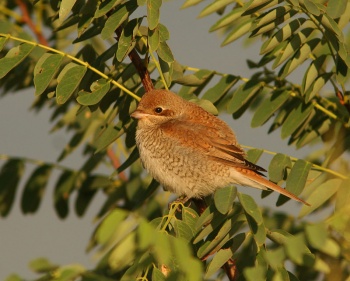(Picture of juvenile uploaded. ID section re-written as virtual C&P. Referenced) |
(Monotypic.) |
||
| Line 1: | Line 1: | ||
| − | + | [[Image:Red-backed_Shrike.jpg|thumb|550px|right|Photo by {{user|Pavlik|Pavlik}} <br />Male and female. Location: Saratov oblast, [[Russia]]]] | |
| − | [[Image:Red-backed_Shrike.jpg|thumb|550px|right|Photo by {{user|Pavlik|Pavlik}}<br />Male and female. Location: Saratov oblast, [[Russia]]]] | ||
;[[:Category:Lanius|Lanius]] collurio | ;[[:Category:Lanius|Lanius]] collurio | ||
==Identification== | ==Identification== | ||
| Line 16: | Line 15: | ||
The birds winter in tropical and southern [[Africa]]. | The birds winter in tropical and southern [[Africa]]. | ||
==Taxonomy== | ==Taxonomy== | ||
| + | Monotypic. | ||
==Habitat== | ==Habitat== | ||
Heathland, overgrown hedges and ditches. | Heathland, overgrown hedges and ditches. | ||
Revision as of 05:50, 3 April 2009
- Lanius collurio
Identification
Rufous-brown above and creamy to pink below. Looks 'long' in flight.
Male
Blue-grey head and rump, with a bold black eye-stripe. Black tail with white sides (reminiscent of Northern Wheatear)
Female
Browner; head grey-brown with a dark cheek patch. Crescent-shaped bands on underparts
Juvenile
Brown above with dark bars. Crescent-shaped bands cover the body.
Distribution
The red-backed shrike was a fairly common summer visitor to the UK 50 years ago but the last confirmed breeding pair was in 1992 (in Scotland?). It can still be seen on passage. It still breeds - though often at low density - in parts of southern and eastern Europe as well as Germany, Norway and Sweden. According to The Birds of the Western Palearctic - Concise Edition there were an estimated 20,00 - 210,000 pairs in Ukraine in 1986, and the population is fairly stable. Its range extends east to western Siberia, and also to north-west Iran.
The birds winter in tropical and southern Africa.
Taxonomy
Monotypic.
Habitat
Heathland, overgrown hedges and ditches.
Behaviour
Breeding
Nests in trees, bushes or bramble thickets.
Diet
The diet includes large insects, small birds, voles and lizards.
As with most other shrike species, it impales it's prey on spikes, thus it is often called the Butcher Bird.
Vocalisation
<flashmp3>Lanius collurio (song).mp3</flashmp3>
Listen in an external program
References
- Wikipedia
- Birdwatchers Pocket Guide ISBN 1-85732-804-3
- Collins Pocket Guide to British Birds 1966
- Collins Field Guide 5th Edition
External Links





